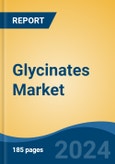Calcium Glycinate is the fastest growing segment, Asia-Pacific is the largest regional market
Speak directly to the analyst to clarify any post sales queries you may have.
10% Free customizationThis report comes with 10% free customization, enabling you to add data that meets your specific business needs.
Key Market Drivers
Increased demand for bioavailable mineral supplements significantly drives the global glycinates market. Consumers increasingly seek highly absorbable nutrient forms, favoring glycinates over traditional inorganic salts due to rising global mineral deficiencies and a greater focus on preventive health. This trend is supported by Balchem Corporation's Q1 2025 earnings report, which noted a 3.7% year-over-year increase in Human Nutrition & Health segment sales, reflecting sustained demand for superior nutritional ingredients. Concurrently, expanding applications in the animal feed sector serve as a crucial driver.Glycinates enhance mineral utilization in livestock, fostering improved animal health, growth rates, and overall productivity, vital for meeting the burgeoning global demand for animal protein. Alltech's 2025 Agri-Food Outlook reported global animal feed production expanded by 1.2% in calendar year 2024, reaching 1.396 billion metric tons, underscoring growth in this critical end-use industry. These forces jointly propel market expansion across human and animal nutrition.
Key Market Challenges
Complex regulatory environments represent a significant impediment to the growth of the global glycinates market. The intricate and often lengthy approval processes for new feed and food additives in key regional markets directly hinder market expansion. This regulatory burden increases operational costs for manufacturers and extends the time required to bring innovative glycinate products to market, thereby reducing their competitive advantage.The impact of these complex regulations is evident in the time and resources companies must allocate for product registration. According to FEFANA, an industrial association, in March 2024, the time companies needed for preparing new feed additive dossiers in the European Union increased by 33.5 days. Such delays discourage investment in research and development for novel glycinate applications, limiting the introduction of new products and constraining overall market dynamism. This ultimately restricts the availability of advanced, highly bioavailable mineral supplements to consumers across various sectors.
Key Market Trends
The rising consumer preference for clean label and organic glycinates significantly shapes market dynamics. This trend highlights a widespread demand for transparency, natural ingredients, and minimal processing in food, beverage, and supplement products. Consumers are increasingly scrutinizing ingredient lists, favoring products that align with perceptions of health and authenticity. According to the Organic Trade Association’s 2025 Organic Market Report, U. S. sales of certified organic products reached a record $71.6 billion in 2024, demonstrating sustained consumer investment in organic options across various categories. This drives manufacturers to invest in organic certifications and clean label formulations for their glycinate offerings, thereby expanding the market for premium and transparent glycinate ingredients.Key Market Players Profiled:
- Ajinomoto Co., Inc.
- Albion Laboratories Limited
- BASF SE
- Clariant International Ltd
- Dunstan Thomas Group Ltd
- Galaxy Surfactants Limited
- Novotech Inc
- Solvay SA
- Shijiazhuang Donghua Jinlong Chemical Co Ltd
- H. Wilhelm Schaumann GmbH & Co KG
Report Scope:
In this report, the Global Glycinates Market has been segmented into the following categories:By Type:
- Magnesium Glycinate
- Zinc Glycinate
- Calcium Glycinate
- Copper Glycinate
- Others
By Application:
- Pharmaceutical/Nutraceutical
- Food Additives
- Feed Additives
- Personal Care Products
- Others
By Region:
- North America
- Europe
- Asia-Pacific
- South America
- Middle East & Africa
Competitive Landscape
Company Profiles: Detailed analysis of the major companies present in the Global Glycinates Market.Available Customizations:
With the given market data, the publisher offers customizations according to a company's specific needs. The following customization options are available for the report.Company Information
- Detailed analysis and profiling of additional market players (up to five).
This product will be delivered within 1-3 business days.
Table of Contents
Companies Mentioned
The companies profiled in this Glycinates market report include:- Ajinomoto Co., Inc.
- Albion Laboratories Limited
- BASF SE
- Clariant International Ltd
- Dunstan Thomas Group Ltd
- Galaxy Surfactants Limited
- Novotech Inc
- Solvay SA
- Shijiazhuang Donghua Jinlong Chemical Co Ltd
- H. Wilhelm Schaumann GmbH & Co KG
Table Information
| Report Attribute | Details |
|---|---|
| No. of Pages | 185 |
| Published | November 2025 |
| Forecast Period | 2024 - 2030 |
| Estimated Market Value ( USD | $ 1.24 Billion |
| Forecasted Market Value ( USD | $ 1.64 Billion |
| Compound Annual Growth Rate | 4.7% |
| Regions Covered | Global |
| No. of Companies Mentioned | 11 |









